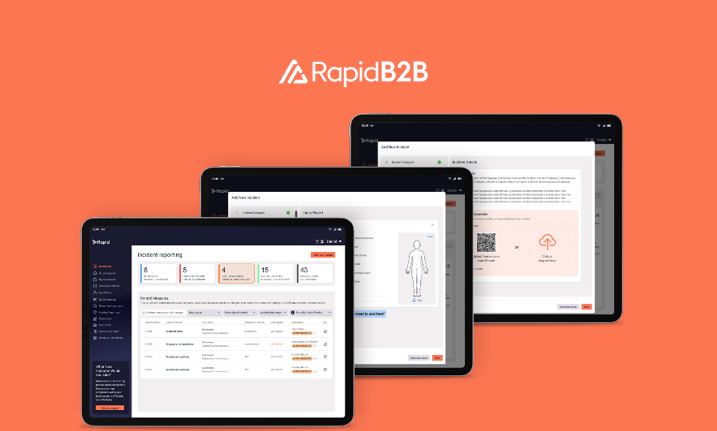

It is difficult for organisations of all sizes to manage incidents successfully. Historically, companies have prioritised monitoring lagging indicators like Time Lost and Number of Incidents.
However, technological advances are transforming safety management. There has never been a better time to rethink your day-to-day processes.
This article explores how you can enhance your current incident management practices, discusses future trends, and highlights exciting innovations to help foster a culture of safety.
The current state
Incident management has become an essential safety task for all businesses, contributing to the identification, correction and prevention of hazards.
Incident reporting is a fundamental aspect of effective incident management. It involves the systematic documentation and communication of any accidents, injuries, or near misses that occur in the workplace. In some serious cases, these incidents may even be required by law to be reported to a local WHS regulator.
Despite its importance and legal necessity, many workers and their managers may neglect or disregard the reporting process. Misunderstandings about responsibilities, fear of repercussions, the time-consuming nature of reporting, or simply the inconvenience of it are just some of the reasons why.
Many reporting processes are complex, with workers being required to fill out onerous paper forms, while following detailed procedure manuals. But with a current average of 180 Australian workers dying per year in workplace incidents, processes must be robust and fit for purpose.
Learn how to build an effective incident reporting process by downloading our free eBook.
The future: advanced incident reporting
Streamline routine processes with software
Using online incident reporting tools allows for faster reporting, as having an online platform accessible to all workers removes the barriers often associated with paper forms.
For example, with Rapid Incident Reporting, administrators can create and print out a QR code that upon scanning enables anyone on-site to report incidents on their phone without delay. This means that front-line workers can report incidents without wrangling paper forms or signing in to a desktop computer.
With Rapid, instant notifications can also be sent to key people as incidents are logged or updated. This streamlined communication facilitates prompt action and a quick response from the relevant managers, leaving a trail of auditable logs to revisit if there are any issues along the way.
A more efficient process also means that more time can be dedicated to carrying out investigations and developing corrective actions, enabling continuous improvement.
Enhance accuracy with automation
Automated systems reduce human error and ensure data collection and reporting consistency. By enabling the immediate capture of information as soon as an incident occurs, key details are less likely to be forgotten. Additionally, the ability to attach photos and other documentation allows for a more comprehensive and detailed account of the incident.
Storing this information in the cloud eliminates the risk of it getting lost or discarded and having readily accessible records assists compliance with regulatory requirements. Analytics can also drive meaningful safety and compliance improvements by giving businesses a complete overview of workplace hazards and trends.
Empower individuals with user-friendly tools
Implementing an intuitive and user-friendly system is essential to ensure all incidents are reported, regardless of whether the individual is an employee, contractor, or an occasional visitor.
While transitioning to an online incident system may raise concerns for workplaces with an older workforce, the advantages outweigh the potential challenges.
At Rapid, we meticulously design our user interfaces to ensure accessibility, making incident reporting a routine task. For instance, Rapid Incident Reporting offers a dashboard that provides administrators with a comprehensive overview of essential metrics and the status of recent incidents.

Ultimately, for any business that still relies on paper-based systems, these intuitive features together with streamlined processes and enhanced accuracy present the opportunity to significantly improve their incident workflow. These features lay the foundations of the current best practice and pave the way for the future of incident management.
Future trends in incident response technologies
Artificial intelligence and machine learning have recently captured significant attention as the newest tools to revolutionise the technology world. Their potential impact on incident management is no exception.
Looking ahead, these advanced systems hold the promise of not only further streamlining the recording of incidents, but also improving the ability to learn from historical data. Enhanced data analytics will give safety professionals nuanced insights, facilitating strategic decision-making.
Predictive analytics for proactive hazard management
One of the most significant examples of advancement in artificial intelligence is predictive analytics, which has the potential to transform the entire incident management process.
Predictive analytics could lead to benefits such as:
- Tailored predictions based on historical data
- Identification of high-risk patterns and hazard trends
- Automation of incident response decision-making processes
Leveraging these insights will allow for more dynamic safety management strategies.
Detect and analyse previously unseen issues
Even though predictive analysis is still in its early stages, the integration of artificial intelligence in safety management is already a reality. Rapid’s latest module, Rapid Aware, is an AI safety system that combines IP cameras and computer vision to monitor the workplace, providing real-time safety alerts and valuable insights for proactive hazard management.
With Rapid Aware, users can track and identify unsafe acts, issues, and trends. It enables the monitoring of risks that may otherwise go unseen and lead to actual incidents. This includes instances of:
- dangerous proximity to forklifts,
- missing PPE like hi-vis vests and hard hats,
- mobile phone use,
- pedestrian exclusion zones,
- general safety concerns.
By gaining visibility into these unsafe actions, organisations can identify leading indicators for more serious issues and take appropriate preventive measures.
One platform for proactive prevention
Truly advanced safety ecosystems rely on interconnected solutions. We are currently working to connect Rapid Aware and AI Monitoring to our entire product suite.
In the case of our Incident Reporting platform, this will enable the automation of incident reports when a hazard or incident is detected via IP cameras, and even faster notifications – as they’ll be issued at the time of the event, not when the report was raised.
And this is just the beginning.
How Rapid can help improve and streamline your incident management
With the right incident reporting system in place, you can embrace the future of incident management and enhance your organisation’s ability to manage workplace incidents proactively.
Want to see our incident management software in action? Talk to our sales team today to explore how Rapid can help protect your operations in the ever-changing business landscape.







